Roasting a dry brined spatchcock turkey is absolutely the best way to prepare your Thanksgiving or Holiday bird! This simple method delivers a crispy golden skin, super juicy white and dark meat, with a perfectly savory and seasoned turkey every time.
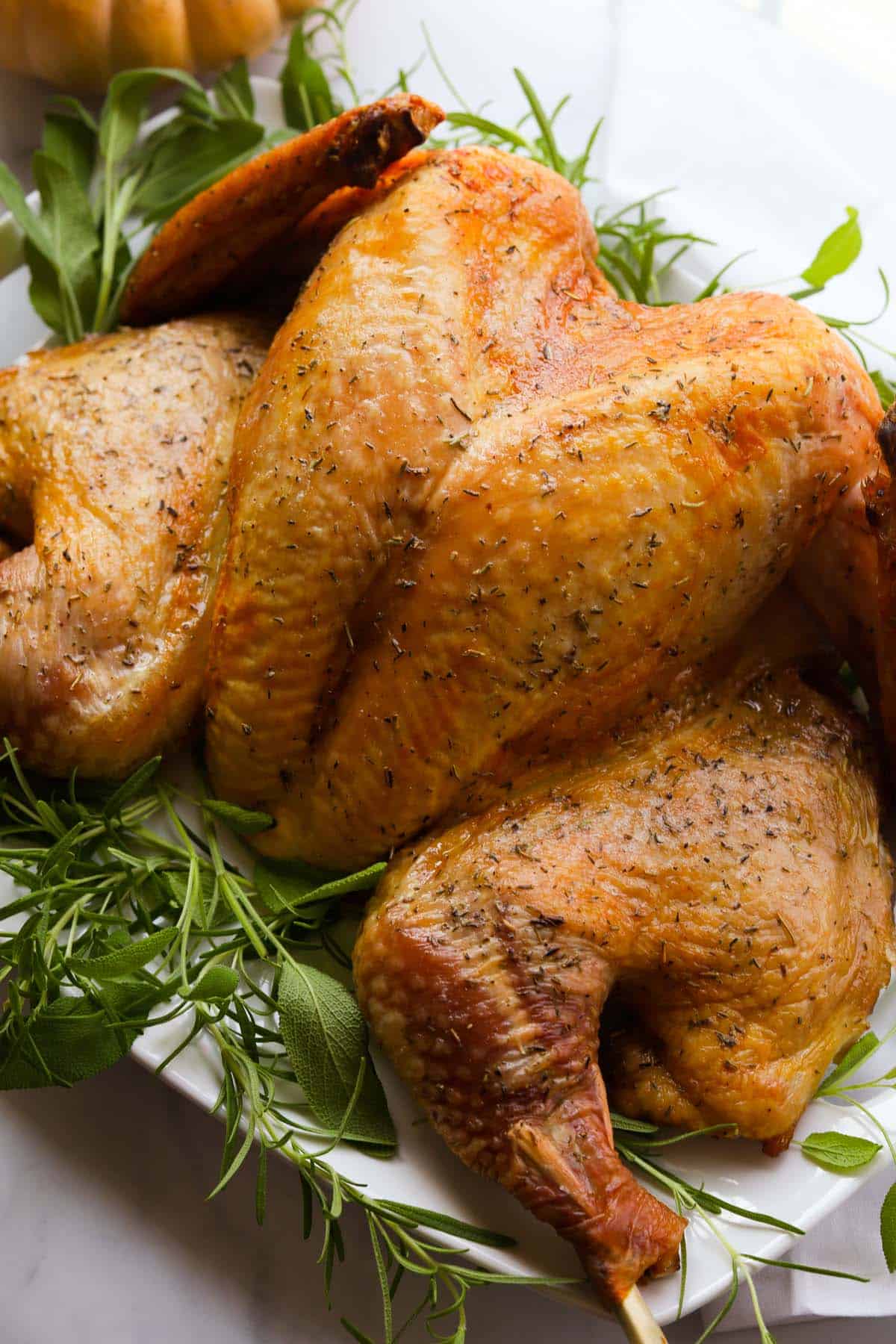
Jump to:
- Reasons to Dry Brine and Spatchcock a Turkey
- What is dry brining?
- Why Dry Brining works
- What is a spatchcock (butterflied) turkey?
- How to make a dry brined spatchcock turkey
- Recommended Equipment
- Roast the Spatchocked Turkey
- Dry Brine Seasoning Variations
- What to serve with a Thanksgiving Turkey
- Pro Tips
- Common Dry Brining mistakes
- Frequently Asked Questions
- Thanksgiving Dry Brine Spatchcock Turkey Prep Calendar
- More Holiday Recipes to Enjoy
- Dry Brine Spatchcock Turkey
Reasons to Dry Brine and Spatchcock a Turkey
- Cuts down cooking time - spatchocking (butterflying) a turkey lays it flat and evens out the thickness of the meat, it significantly cuts down on the cooking time. A 14 pound turkey usually cooks for 3 hours, when it's spatchcocked, it will only take about 1 ½ to 2 hours total!
- Flavorful and juicy meat - Dry brining distributes the flavors thoroughly into the meat and roasting the spatchcocked turkey ensures even cooking with juicy meat.
- Crispy skin - dry brining draws the moisture from the skin, drying it out, resulting in roasted, golden crispy skin.
- No wet brine hassle - a dry brine is much easier than a wet brine. With a dry brine, there is no need for a large container, gallons of liquid or extra refrigerator space for a large bucket like container! Mixing the wet brine ingredients also takes a lot of prep work to heat the water and ensure it’s mixed and dissolved through.
What is dry brining?
Dry brining is a method of pre seasoning meat with salt and other seasonings (herbs or spices) and allowing it to rest and penetrate the meat prior to cooking.
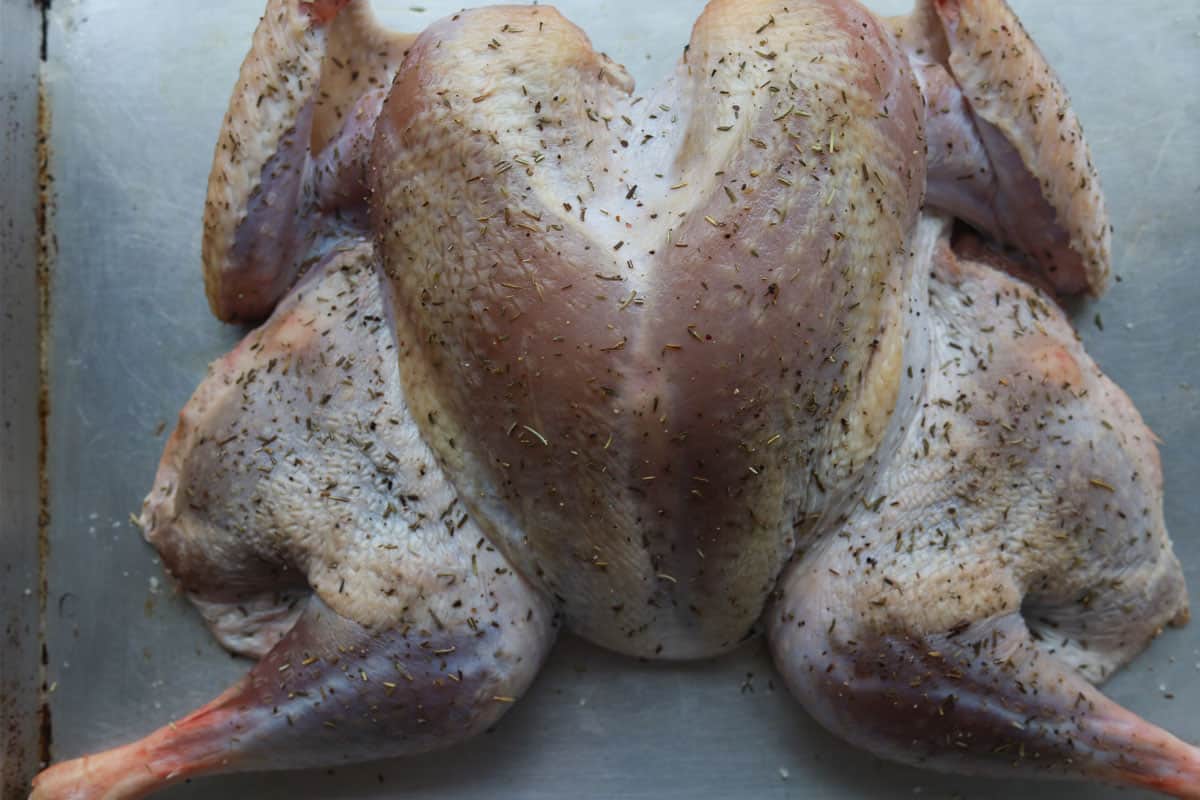
Why Dry Brining works
Salt is the key ingredient to brining. When salt is added to the skin of the turkey it will draw the natural juices and water out of the meat. Over time, the salty liquid will be reabsorbed back into the meat, carrying the seasoning and flavors deep inside resulting in moist and flavorful turkey.
What is a spatchcock (butterflied) turkey?
Spatchcocking, also called butterflying a turkey, is the technique of removing the backbone and laying it out flat to cook. Doing this allows the turkey to cook evenly, yielding crispy skin and perfectly tender white and dark meat.
You can spatchcock a turkey at any size. We usually cook a 13 to 15 pound turkey for small gatherings. When we have my family over (and feeding about 20 people or so) we make TWO 12 to 14 pound turkeys. The meat will be more moist and tender from two smaller birds. Also, roasting a spatchcocked turkey bigger than 15 pounds will be hard to fit on a roasting pan and in the oven!
How to make a dry brined spatchcock turkey
Ingredients
Turkey - Frozen or fresh turkey is fine. Frozen is more economical. I would choose smaller sized turkeys as it thaws quicker and cooks quicker too. Smaller turkeys also cook more consistently. For a larger crowd, I opt for 2 smaller sized turkey around 14 pounds each to cook.
Seasoning -Salt, pepper, thyme and rosemary is all you need to get a delicious flavor.
Butter, garlic butter or olive oil - This helps give a beautiful golden color to the turkey.
Recommended Equipment
Kitchen shears - Sharp kitchen shears is highly recommended. Cutting out the backbone will require some elbow grease and using heavy duty shears will help make the cutting easier.
Roasting sheet pan - A large, full size sheet pan works best, 26” x 18” (or similar).
Meat thermometer - Digital or analog works just fine to check the internal temperature of the turkey.
How to spatchcock a turkey
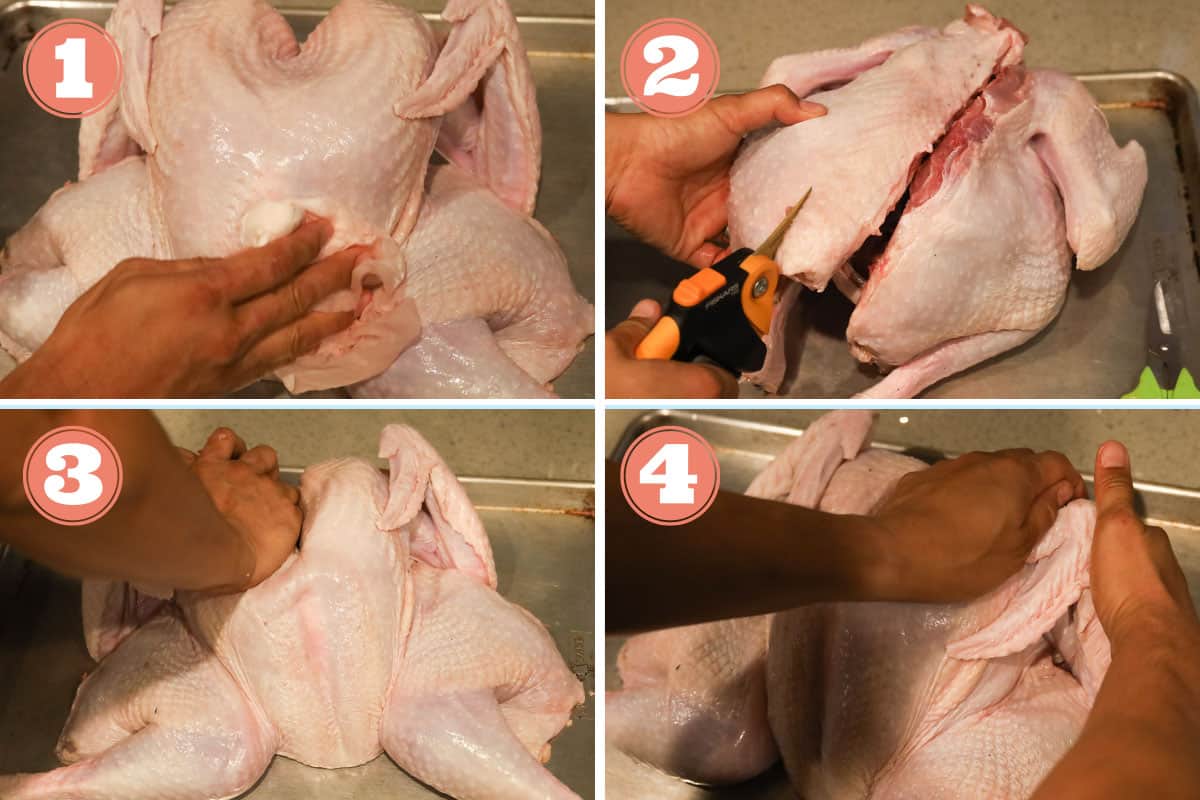
1). Fully thaw the turkey in your fridge. Rule of thumb is 24 hours for every 5 pounds of turkey. Remove the turkey neck and giblets from the body cavity, snip out the kidneys if it's still in the cavity, save these for giblet gravy! Make sure to also check the neck cavity as sometimes the gizzards are placed there in a bag. Pat dry the cavity and outside part of the turkey with paper towels.
2). Locate the backbone, facing it up towards you. Using kitchen sears, cut along each side of the back bone from the tail to neck.
3). Turn the turkey over, skin side up. Use the heel of your hands, apply pressure (put your weight into it!) on the upper middle of one side of the breast bone to break it. You may hear a small crack.
4). Repeat on the other side of the breast bone.
How to dry brine a spatchcock turkey
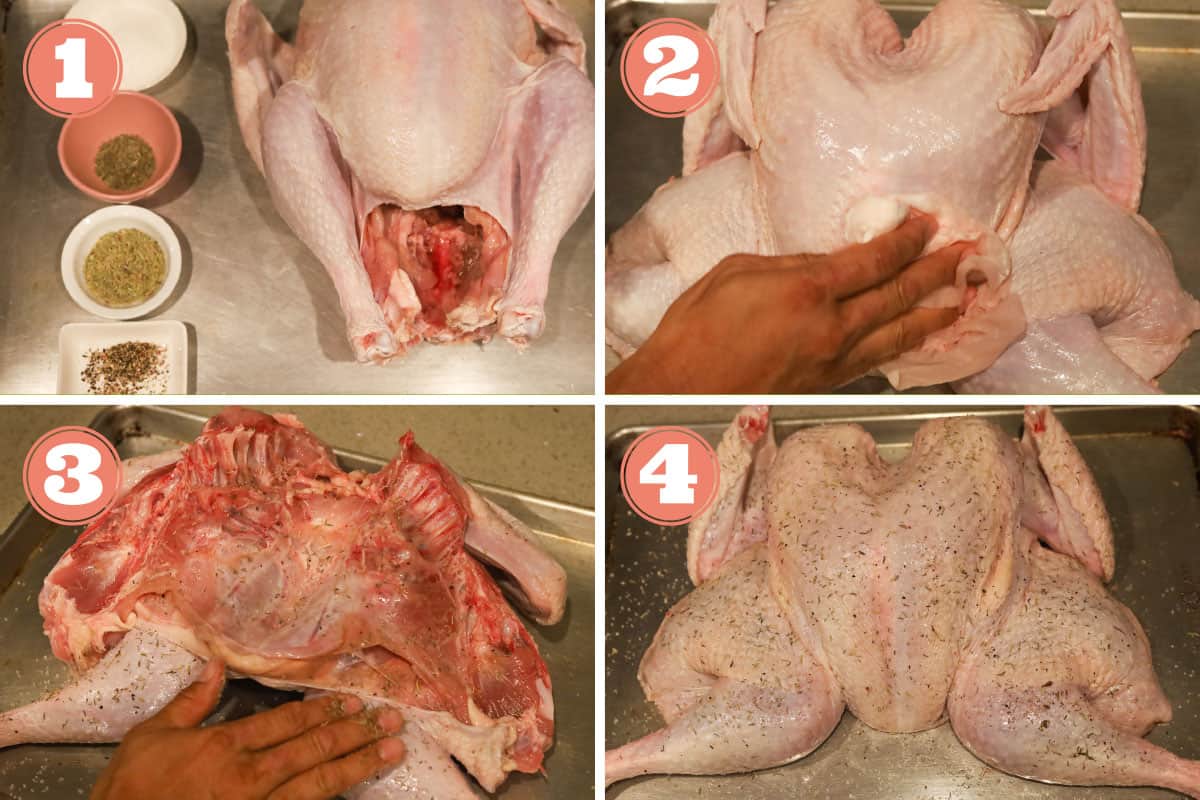
1). Mix the dry brine seasoning together.
2). After spatchcocking the turkey, completely dry the inside and outside of the turkey again.
3). Season the cavity part of the turkey first, using ⅓ of the seasoning. Then turn it over and use the rest of the seasoning on the skin.
4). Place the turkey skin side up, laying it flat on a clean sheet pan and place it in the fridge, uncovered for 2 to 3 days. Make sure nothing is touching it, and that nothing stored in the door will touch it when closed.
Roast the Spatchocked Turkey
To cook, preheat the oven to 350 Fahrenheit. Dry any residual moisture on the turkey and pan. Place the turkey in the middle rack uncovered and roast for 1 hour. After the hour, add butter or olive oil to the skin so it will crisp up nicely.
Check the temperature at 1 hour and 30 minutes. Keep roasting until it reaches 165 degrees Fahrenheit at the deepest point of the breast, then remove from the oven. The temperature will normally rise another 5 degrees Fahrenheit.
Let it rest for at least 20 minutes before carving or all the juice will run out and your meat will be dry.
Carve the Turkey
Use a sharp knife to first cut the legs from the breast. Remove the drumsticks from the thigh, then cut the wing from the breast. Lastly, slice the breast meat in 1 inch thickness. Place on the platter and garnish with optional decorative fruit and herbs to serve.
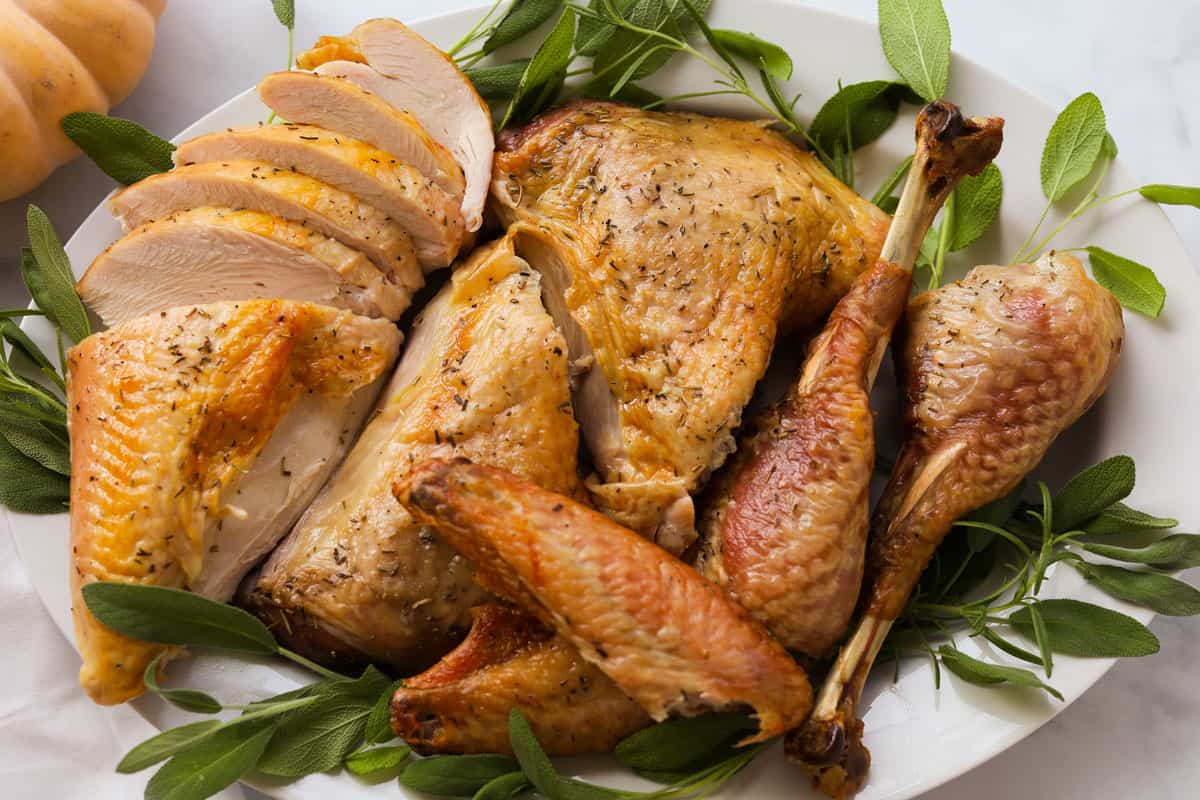
Dry Brine Seasoning Variations
Looking for additional flavoring options for your turkey? Try these easy spice combinations:
- Holiday Herb (thyme, rosemary, sage)
- Refreshing Citrus herbs (orange zest, lemon zest, thyme)
- BBQ inspired (paprika, cumin, garlic powder)
What to serve with a Thanksgiving Turkey
Carve and serve with some amazing giblet gravy and sides like Instant Pot mashed potatoes and green bean casserole!
Pro Tips
- Save the giblets and backbone to make a delicious gravy!
- Trim the tips of the wings off at the joint (save it to make gravy), as it burns easily or you can tuck the wings under the body of the turkey.
- Minimize opening the oven door. It drops the temperature and you won’t get that golden brown, crispy skin.
- Make sure the turkey is thawed through. One year our turkey was too big and we underestimated the thawing time. The turkey did not cook evenly or quickly!
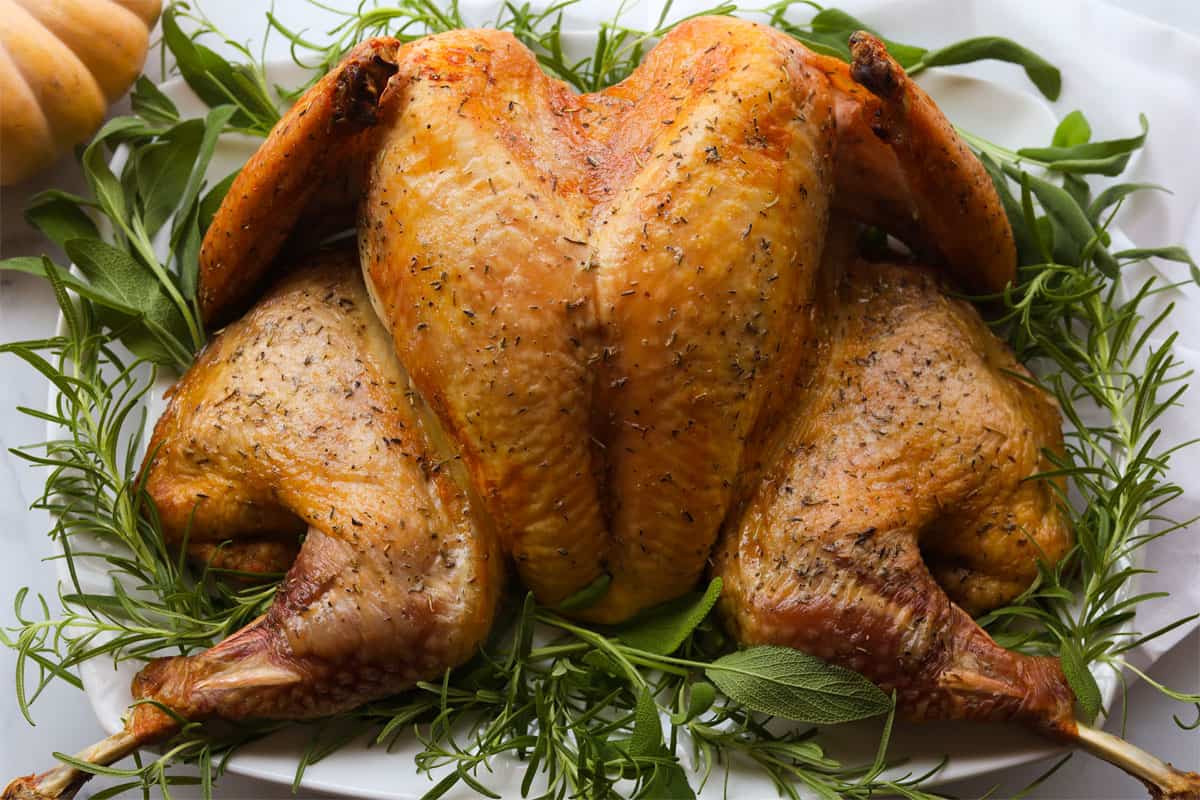
Common Dry Brining mistakes
Using the wrong salt - use kosher coarse salt for easier and more even distribution. Since the grains are larger, it is easier to see and spread evenly, it also will not clump up as easily compared to table salt.
Not using enough salt - make sure to use the recommended salt amount to season the turkey. Skimping on the salt (the primary ingredient for brining) won’t brine the turkey thoroughly.
Uneven seasoning- Be sure to season the turkey on both sides and around the wings and legs to ensure every bit is flavorful!
Not allowing enough time - make sure to give ample time for the brining. Since a turkey is a large protein, allow at least 24-28 hours to absorb the salt and seasoning.
Skipping on the drying - prior to roasting, ensure the turkey is thoroughly dried inside and out from residual moisture. This removes excess moisture and delivers a golden crispy roasted skin.
Frequently Asked Questions
The cooking time depends on the size of the turkey, cooking temperature and oven. At 350 F., general rule is about 6 minutes per pound. Roasting a 14 pound turkey will take about 90- 120 minutes. Make sure to always use a meat thermometer for more accurate reading.Remove the turkey when the internal temp reaches 160, when it’s resting, the temp will increase to about 5 degrees.
You can dry brine a turkey anywhere from 2 to 3 days in the refrigerator uncovered. Thai gives enough time for the salt to penetrate and season the meat thoroughly.
No, rinsing the turkey is unnecessary and makes it likely for bacteria to spread on your sink and kitchen counters. Rinsing the turkey will also introduce more moisture to the skin, which can dilute the flavor and prevent crispy skin. Just pat dry the turkey before roasting.
There is no need to salt or season the meat again after dry brining. After dry brining for the recommended time, the salt and seasoning are already absorbed into the meat well enough.
The thermometer should be inserted deep into the thickest part of the breast, without touching the bone. You should also check the temperature near the wing joint, where the wing meets the breast, since this area can take longer to cook through.
Thanksgiving Dry Brine Spatchcock Turkey Prep Calendar
| Day | Tasks |
|---|---|
| 🧊4–5 Days Before (Fri/Sat) |
• Buy a 12–15 lb turkey (or two smaller ones). • If frozen, place in fridge to thaw (24 hours per 5 lbs). |
| 🔪2–3 Days Before (Mon/Tues) |
• Spatchcock turkey (remove backbone, flatten). • Pat dry and apply dry brine. • Refrigerate uncovered on a sheet pan. |
| 🧂1 Day Before (Wed) |
• Check turkey skin — it should look dry. • Optional: make stock from giblets/backbone. |
| 🔥Thanksgiving Day (Thu) |
• Roast at 350°F for ~1½–2 hours. • Remove at 160°F breast temp (will rise while resting). • Rest 20 minutes, carve, and serve. |
More Holiday Recipes to Enjoy
Love a recipe you've tried? Please leave a 5-star 🌟rating in the recipe card and a comment below! That'll make my day!
Let's be friends! Follow me on social media @ Instagram, Pinterest. Give me a tag @apeachyplate when you try out a recipe!
Dry Brine Spatchcock Turkey
Ingredients
- 14 pound whole turkey
- 3 tablespoons kosher salt if using table salt, half the amount.
- ½ tablespoon dried thyme
- ½ tablespoon dried rosemary
- 1 teaspoon ground pepper
- 1-2 tablespoons butter or olive oil
Instructions
- Fully thaw the turkey in your fridge. Rule of thumb is 24 hours for every 5 pounds of turkey.
- Remove the turkey neck and giblets from the body cavity, cut out the kidneys if it has not been removed. Make sure to also check the neck cavity as sometimes the gizzards are placed there in a bag.
- Thoroughly pat dry the cavity and skin of the turkey with paper towels. Locate the backbone, facing it up towards you. Using kitchen sears, cut along each side of the back bone from the tail to neck. Use scissors to snip at the skin and fatty tissue near the neck as needed.
- To spatchcock, turn the turkey over, skin side up. Use the heel of your hands, apply pressure (put your weight into it!) on the upper middle of one side of the the breast bone to break it. You may hear a small crack. Repeat on the other side of the breast bone.
- To season the turkey, use paper towels to completely dry the inside and outside of the turkey again. Place the turkey on a clean and dry roasting sheet. Season the cavity of the turkey first, using ⅓ of the seasoning. Then turn it over and season the skin with the remaining seasoning.
- Place the turkey skin side up, laying it flat on the sheet pan and place it in the fridge, uncovered for 2 to 3 days.
- To cook, preheat oven to 350 Fahrenheit. Use a paper towel to dry any residual moisture on the turkey. Place the roasting tray with turkey in the middle rack uncovered and cook for 1 hour. After the hour, add butter or olive oil to the skin so it will crisp up and brown nicely.
- Check the temperature at 1 hour 30 minutes. Keep roasting until it reaches 160 degrees at the deepest point of the breast, then remove from the oven. The temperature will normally rise another 5 degrees Fahrenheit. Let it rest for at least 20 minutes before carving.
Notes
- Save the giblets and backbone to make a delicious gravy!
- Trim the tips of the wings off at the joint (save it to make gravy), as it burns easily or you can tuck the wings under the body of the turkey.
- To check the doneness, place the thermometer deep in the thickest part of the breast. You should also check the temp near the wing joint, where the wing meets the breast.
- You can spatchcock a turkey at any size. However, roasting a spatchcocked turkey bigger than 15 pounds will be hard to fit on a roasting pan and in the oven. Roasting two smaller birds from 12 to 14 pounds will give you meat that's more moist and tender.
- Use sharp kitchen shears.

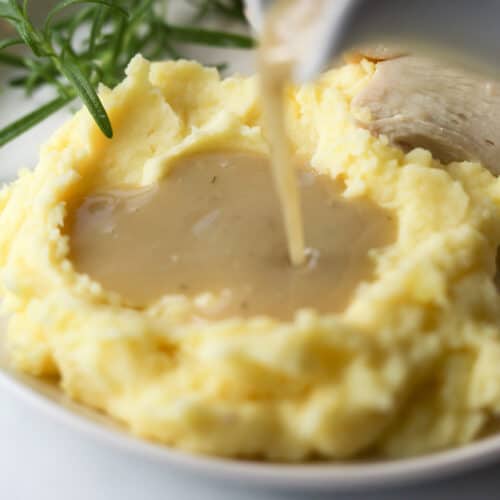
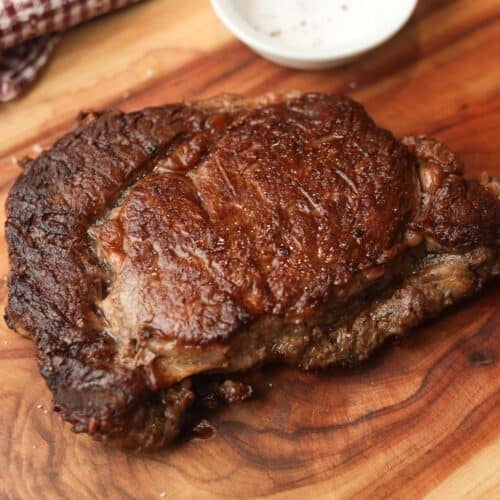
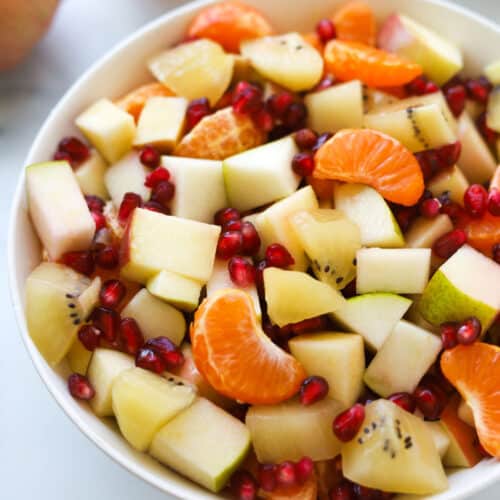
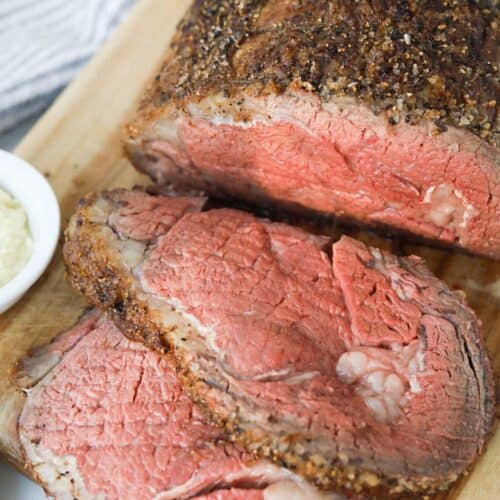
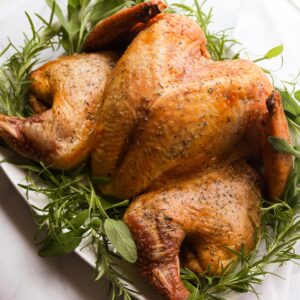
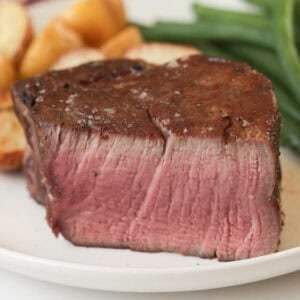
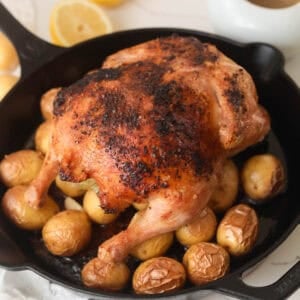
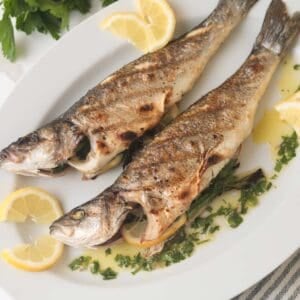

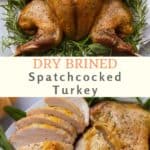
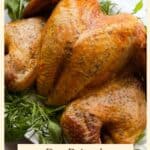
Gladys
Great idea! How do you cook 2 turkeys for a large family?
Do you cook them at the same time? Do you use 2 racks?
Kaylie
I've actually done this several Thanksgivings in a row! I'll cook two spatchcocked turkeys on two racks, one on the next to last level of the oven, and one at least 2" above, leaving at least two inches above the second turkey so air can circulate. I'll roast them like this for 45 min, then switch positions, moving the bottom turkey to the top rack, and the top to the bottom. Roast for another 45 min or so, or until the internal temp reaches 165 in the thickest part of the breast. If the bottom turkey's skin isn't browned enough, roast under the broiler until it reaches a nice golden brown (but not burnt).